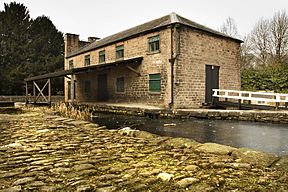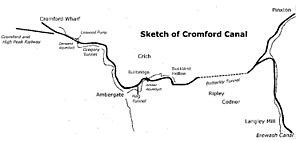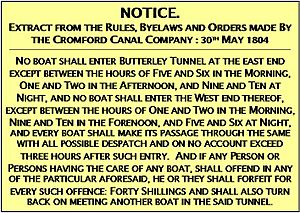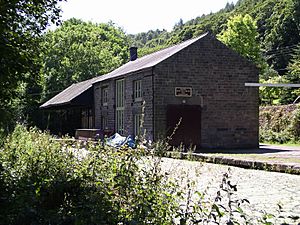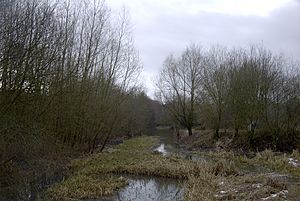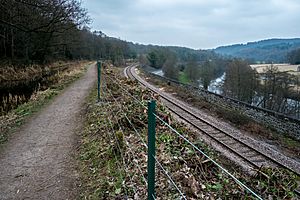Cromford Canal facts for kids
The Cromford Canal is a historic waterway in Derbyshire, England. It stretches about 14.5 miles (23.3 km) from Cromford to the Erewash Canal. There was also a branch that went to Pinxton.
This amazing canal was designed by William Jessop and Benjamin Outram. It features four tunnels and 14 locks to help boats move up and down hills.
The canal starts in Cromford and follows the River Derwent valley. It then turns east along the Amber valley. At Bullbridge, it crosses the river and a road using a special bridge called an aqueduct.
From there, it goes towards Ripley and through the long Butterley Tunnel. After the tunnel, it reaches Ironville, where the Pinxton branch begins. The canal then goes down through 14 locks to meet the Erewash Canal at Langley Mill.
The Pinxton branch was very important for moving Nottinghamshire coal. This coal could then travel on the Erewash Canal to the River Trent and even to Leicester.
Today, a 6-mile (9.7 km) part of the canal between Cromford and Ambergate is special. It's a Biological Site of Special Scientific Interest (SSSI) and a Local Nature Reserve. This means it's a protected area for nature.
The canal also connected with the Cromford and High Peak Railway. This railway carried goods across the Peak District. It met the canal at High Peak Junction using a steep slope.
Contents
Why Was the Canal Built?
In the late 1700s, people wanted to expand the Erewash Canal. They hoped to help coal mining grow further north. When the canal company said no, local business people decided to build their own canal.
They asked William Jessop to design a canal from Langley Mill to Cromford. It would also have a branch to Pinxton. This new canal would carry coal to busy Cromford. It would also move limestone for the growing iron industry.
Other important goods included lead from Wirksworth and cotton from the Cromford mills. Connecting to the Erewash Canal would link the area to the Trent and Mersey Canal. This meant goods could travel across much of England.
Powerful people like Philip Gell and Sir Richard Arkwright supported the canal. They knew it would bring many benefits.
Solving Water Problems
Building a canal meant finding enough water. Many mill owners along the Derwent were worried. They feared the canal would take too much water from their mills.
Jessop and Benjamin Outram spent over a year measuring the Derwent's water flow. This helped them prove to Parliament that there would be enough water. They also planned to make the canal's highest section very deep. This way, it could store enough water to last a week, even in dry weather.
The canal was designed in two parts. The section from the Erewash Canal was wide enough for large barges. But through the Butterley Tunnel and the narrow Derwent valley, it was built for smaller "narrow boats."
Just before the plan went to Parliament, Richard Arkwright raised a concern. He wanted the canal to get water from the river by raising a weir at his Masson Mill. This would help his mill, but the canal committee agreed to it.
Building the Canal
The plan for the Cromford Canal became a law in 1789. Building the canal was tough, and the first contractors ran into money problems. They left the job in 1790.
Benjamin Outram quickly took over managing the project. In 1792, the Amber Aqueduct, a bridge for the canal, broke. But by May, most of the canal east of Butterley was nearly finished.
Digging the Butterley Tunnel
The Butterley Tunnel was a huge challenge. Workers dug 33 shafts, like deep wells, about 75 yards (68 m) apart. Some shafts were as deep as 57 yards (52 m). This allowed many teams to work on the tunnel at the same time.
Most of the tunnel went through soil, but some parts had coal and iron ore. The finished tunnel was lined for most of its length to make it strong.
By 1793, the canal company had very little money left. The cost had risen to about one and a half times the first guess. But even unfinished, the canal was already starting to earn money.
In August, there were more problems with the Derwent Aqueduct. Its walls had cracked because of the water pressure. Jessop believed the special lime used in the mortar was too pure and took too long to set. Later, engineers realized the walls were simply too thin.
Jessop fixed the aqueduct at his own cost. He added strong metal bars and extra arches to support it. Finally, in 1794, the canal opened. Even though it cost about twice the first estimate, it was a big success!
How the Canal Worked
The canal was expected to carry limestone and coal. But it also helped new businesses grow.
The Cromford Canal mainly carried coal, lead, and iron ore. Some of these materials were even dug out from inside the Butterley Tunnel. Copper came from places as far as Ecton Hill.
The canal also helped move lead from Ecton and Wirksworth to the Lead Market in Hull. It also carried a type of rock called chert from Bakewell to the Potteries (where pottery was made).
Finished goods from the area, like castings from the Butterley Company and cotton from Arkwright's mills, could also be sent out widely. New canals like the Derby Canal and the Nottingham Canal (both opened in 1796) helped even more.
Water Supply and Tunnel Rules
Richard Arkwright had suggested getting water from the Derwent River. But the canal owners secretly decided to get water from the Cromford sough. A sough is a drainage tunnel from mines.
They bought land from Arkwright and connected to the sough. Water from the sough could be used at night and on Sundays when Cromford Mill wasn't working. This underground water was slightly warm and never froze.
The opening of the Nottingham Canal also provided more water. This came from the Butterley Reservoir, which was almost above the Butterley Tunnel.
Signs like the one shown were placed at both ends of the Butterley Tunnel. They told boat captains when they could go through. This was important because the tunnel was narrow, and only one direction could pass at a time. People were fined if they didn't follow these rules!
In 1819, the Mansfield and Pinxton Railway opened. This brought more trade, including moulding sand for foundries. In 1831, the Cromford and High Peak Railway opened a route to Manchester.
The canal also carried limestone from the Butterley Company's quarry at Crich. A special railway, called a plateway, brought the limestone to the Amber Wharf at Bullbridge.
In 1840, a new railway line, the North Midland Railway, was built. At Bullbridge, the engineer George Stephenson had a challenge. He had to build the railway over the road but under the canal. So, the Bullbridge Aqueduct ended up with the river, road, railway, and canal all at different levels!
In 1846, a new mine drainage tunnel, Meerbrook Sough, was built. This took water away from both Arkwright's mill and the canal. The canal was left with only water from Butterley Reservoir. So, in 1849, the canal owners built the Leawood Pump House. They bought a large beam engine to pump water from the River Derwent into the canal.
The Canal's Decline
In 1802, the canal carried over 150,000 tons of goods. By 1842, it carried almost 300,000 tons. But then, in 1849, a new railway line was built next to the canal. More railway lines followed.
By 1888, trade on the canal had dropped to only 45,000 tons a year. In 1889, parts of the Butterley Tunnel collapsed. This closed the tunnel for four years. More collapses in 1900 closed the tunnel for good.
Most of the canal was officially closed in 1944. A small half-mile (800m) section to Langley Mill closed in 1962. The Bullbridge Aqueduct was removed in 1968 when the road was made wider. In 1985, the Codnor Park Reservoir was made shallower to help prevent floods.
Bringing the Canal Back to Life
After it closed, the canal was taken over by the British Waterways Board. In 1974, Derbyshire County Council bought it.
Between 1968 and 1989, a 5-mile (8 km) section between Cromford and Ambergate was partly or fully restored. The Leawood Pump House and its beam engine were also fixed. The engine now pumps water from the River Derwent back into the canal.
The Cromford Canal Society used to run horse-drawn passenger boats. These boats carried up to 15,000 people a year on a 1.5-mile (2.4 km) section. They also ran the beam engine regularly.
Today, about 5 miles (8 km) of the canal still have water. In 2013, work began to clean out a 1.3-mile (2.1 km) section. This was done to make it deep enough for narrowboats again. This section is now open for boats.
The towpath, which is the path next to the canal, is very popular for walking. It goes from Ambergate to Cromford. You can see the Derwent Valley Line railway, the Leawood Pump House, and the High Peak Junction of the Cromford and High Peak Railway.
Friends of the Cromford Canal
The Friends of the Cromford Canal is a charity that wants to restore the canal. Their goal is to make the canal fully navigable again. They hope to connect it to the national canal system at Langley Mill.
The group runs a trip boat called Birdswood. It travels between Cromford Wharf and Leawood Pump House. Even after the cleaning work in 2013, some parts are still quite shallow. Famous English actor Brian Blessed is the president of this group.


